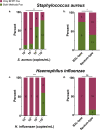Evaluation of the BioFire FilmArray Pneumonia Panel for Detection of Viral and Bacterial Pathogens in Lower Respiratory Tract Specimens in the Setting of a Tertiary Care Academic Medical Center
- PMID: 32321782
- PMCID: PMC7315030
- DOI: 10.1128/JCM.00343-20
Evaluation of the BioFire FilmArray Pneumonia Panel for Detection of Viral and Bacterial Pathogens in Lower Respiratory Tract Specimens in the Setting of a Tertiary Care Academic Medical Center
Abstract
Our objective was to evaluate the diagnostic yield and accuracy of the BioFire FilmArray pneumonia panel (BFPP) for identification of pathogens in lower respiratory tract specimens (n = 200) from emergency department (ED) and intensive care unit (ICU) patients at a tertiary care academic medical center. Specimens were collected between January and November 2018, from patients ≥18 years of age, and culture was performed as part of standard-of-care testing. The BFPP identified a viral or bacterial target in 117/200 (58.5%) samples, including Staphylococcus aureus in 22% of samples and Haemophilus influenzae in 14%, and both a viral and bacterial target in 4% of samples. The most common viruses detected by BFPP were rhinovirus/enterovirus (4.5%), influenza A virus (3%), and respiratory syncytial virus (RSV) (2%). Overall, there was strong correlation between BFPP and standard methods for detection of viruses (99.2%) and bacteria (96.8%). Most bacteria (60/61 [98.4%]) detected by standard methods were also identified by BFPP, and 92 additional bacteria were identified by BFPP alone, including 22/92 (23.9%) additional S. aureus isolates and 25/92 (27.2%) H. influenzae isolates, which were more frequently discordant when detected at low concentrations (S. aureus, P < 0.001; H. influenzae, P < 0.0001) and in sputum-type specimens (S. aureus, P < 0.05). A potential limitation of the BFPP assay is the absence of fungal targets and Stenotrophomonas maltophilia, which were detected in 26 and 4 of 200 specimens, respectively. Real-time specimen analysis with BFPP has the potential to identify bacterial pathogens and resistance markers 44.2 and 56.3 h faster than culture-based methods. The BFPP is a rapid and accurate method for detection of pathogens from lower respiratory tract infections.
Keywords: BioFire; pneumonia; quantitative PCR; syndromic testing.
Copyright © 2020 American Society for Microbiology.
Figures






Similar articles
-
Evaluation of the BioFire FilmArray Pneumonia Panel Plus to the Conventional Diagnostic Methods in Determining the Microbiological Etiology of Hospital-Acquired Pneumonia.Biology (Basel). 2022 Feb 27;11(3):377. doi: 10.3390/biology11030377. Biology (Basel). 2022. PMID: 35336751 Free PMC article.
-
Performance of a multiplex PCR pneumonia panel for the identification of respiratory pathogens and the main determinants of resistance from the lower respiratory tract specimens of adult patients in intensive care units.J Microbiol Immunol Infect. 2019 Dec;52(6):920-928. doi: 10.1016/j.jmii.2019.10.009. Epub 2019 Nov 23. J Microbiol Immunol Infect. 2019. PMID: 31806539 Free PMC article.
-
Multicenter Evaluation of the ePlex Respiratory Pathogen Panel for the Detection of Viral and Bacterial Respiratory Tract Pathogens in Nasopharyngeal Swabs.J Clin Microbiol. 2018 Jan 24;56(2):e01658-17. doi: 10.1128/JCM.01658-17. Print 2018 Feb. J Clin Microbiol. 2018. PMID: 29212701 Free PMC article.
-
The FilmArray® respiratory panel: an automated, broadly multiplexed molecular test for the rapid and accurate detection of respiratory pathogens.Expert Rev Mol Diagn. 2013 Nov;13(8):779-88. doi: 10.1586/14737159.2013.848794. Expert Rev Mol Diagn. 2013. PMID: 24151847 Free PMC article. Review.
-
Identification of bacterial co-detections in COVID-19 critically Ill patients by BioFire® FilmArray® pneumonia panel: a systematic review and meta-analysis.Diagn Microbiol Infect Dis. 2021 Nov;101(3):115476. doi: 10.1016/j.diagmicrobio.2021.115476. Epub 2021 Jul 1. Diagn Microbiol Infect Dis. 2021. PMID: 34303085 Free PMC article.
Cited by
-
Co-infections in COVID-19 critically ill and antibiotic management: a prospective cohort analysis.Crit Care. 2020 Jul 9;24(1):410. doi: 10.1186/s13054-020-03135-7. Crit Care. 2020. PMID: 32646494 Free PMC article. No abstract available.
-
Optimized Antibiotic Management of Critically Ill Patients with Severe Pneumonia Following Multiplex Polymerase Chain Reaction Testing: A Prospective Clinical Exploratory Trial.Antibiotics (Basel). 2024 Jan 10;13(1):67. doi: 10.3390/antibiotics13010067. Antibiotics (Basel). 2024. PMID: 38247626 Free PMC article.
-
Supporting Clinical Decisions with Rapid Molecular Diagnostic Pneumonia Panel in Pediatric Intensive Care Unit: Single Center Experience in Turkiye.Microorganisms. 2023 Sep 25;11(10):2391. doi: 10.3390/microorganisms11102391. Microorganisms. 2023. PMID: 37894049 Free PMC article.
-
Utility of a multiplex pathogen detection system directly from respiratory specimens for treatment and diagnostic stewardship.Microbiol Spectr. 2024 Jun 4;12(6):e0375923. doi: 10.1128/spectrum.03759-23. Epub 2024 May 7. Microbiol Spectr. 2024. PMID: 38712971 Free PMC article.
-
Accuracy of Molecular Amplification Assays for Diagnosis of Staphylococcal Pneumonia: a Systematic Review and Meta-analysis.J Clin Microbiol. 2021 Jul 19;59(8):e0300320. doi: 10.1128/JCM.03003-20. Epub 2021 Jul 19. J Clin Microbiol. 2021. PMID: 33568465 Free PMC article.
References
-
- WHO. 2019. World health statistics 2019: monitoring health for the SDGs, sustainable development goals. World Health Organization, Geneva, Switzerland.
-
- Metlay JP, Waterer GW, Long AC, Anzueto A, Brozek J, Crothers K, Cooley LA, Dean NC, Fine MJ, Flanders SA, Griffin MR, Metersky ML, Musher DM, Restrepo MI, Whitney CG. 2019. Diagnosis and treatment of adults with community-acquired pneumonia. An official clinical practice guideline of the American Thoracic Society and Infectious Diseases Society of America. Am J Respir Crit Care Med 200:e45–e67. doi:10.1164/rccm.201908-1581ST. - DOI - PMC - PubMed
Publication types
MeSH terms
LinkOut - more resources
Full Text Sources
Medical

